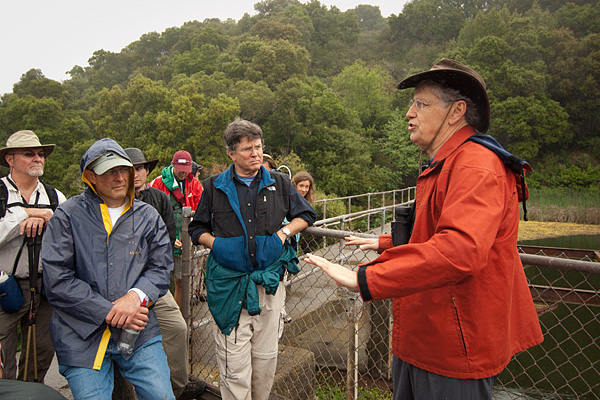Who knew water would be a historical 'hot issue?'
David Freyberg, who studies dams – particularly Searsville Dam – recently took members of the Historical Society on a slide-show tour of Stanford's elaborate water system. The good news is that potable water use on campus is trending down. The bad news is that Stanford's dams, which provide much of the university's non-potable water, are aging.
When Stanford Historical Society President Charles Junkerman invited David Freyberg, associate professor of civil and environmental engineering, to give a talk last week on Stanford's water systems at a society meeting, he had no idea water would become, as he put it, "one of the hottest issues going."
In fact, when he introduced Freyberg, Junkerman, associate provost and dean of Continuing Studies and Summer Session, held up a news magazine whose cover story focused on the impending scarcity of clean water worldwide. The timeliness of the subject meant that about 100 Historical Society members crowded into Room 2 in Lane History Corner to hear Freyberg's talk. Freyberg studies dams and, in particular, Stanford's Searsville Dam, located in the foothills.
For an hour, Freyberg took society members on a slide-show tour of Stanford's elaborate water system, focusing on potable water, non-potable water and the university's three dams.
One of his best pieces of advice: "Don't drink from the fire hydrants with red tops. Those have non-potable water. The white tops mean potable."
Freyberg traced the history of water use in this area from an initial reliance before the Gold Rush on springs and streams to use of scattered wells and groundwater from the turn of the century to the 1930s to today's dependence on the Hetch Hetchy Reservoir, as provided by the San Francisco Public Utilities Commission.
The good news, Freyberg said, is that Stanford's use of potable water has been trending downward because of the university's aggressive reduction efforts. Stanford used about 2.15 million gallons per day of potable water in 2009, split almost equally among four uses: academic and administrative buildings; student housing and dining; faculty housing; and the cogeneration plant.
The bad news, if there is any, is that Stanford's three dams are aging and likely to "create an interesting set of issues," Freyberg said.
Those dams include the on-campus Lagunita, which was built by Leland Stanford to hold irrigation water for his farm. It leaks about 500 gallons per minute when full and isn't very useful for storing water today. Instead, the area is a habitat for the endangered California tiger salamander, which prefers to amble out of the foothills and into soggy areas for mating.
Far more critical to water use is the dam at Felt Lake, west of Interstate 280, which was built by Job Felt in 1878, purchased by Leland Stanford in 1887, enlarged in 1889 and replaced around 1930. That water is crucial for irrigation and fire protection. Improvements made in 2009 have made it easier for endangered steelhead trout to wind their way around the diversion dam for the reservoir on Los Trancos Creek.
Equally important is Searsville Dam in the Jasper Ridge Biological Preserve. The dam – the only one of the three located directly on a stream – was built in 1892 by the for-profit Spring Valley Water Company and acquired by the university in 1919.
Freyberg showed society members a postcard of people riding around the lake on horseback, reflecting Searsville's recreational past. Today, however, the lake suffers from rapid sedimentation and low water quality. But it, too, is crucial for irrigation, fire protection, habitat preservation and teaching and research.
The two are major sources for the 1 million gallons per day in non-potable water used at Stanford, about half of which is used for irrigation on athletic lands.
"The removal of these sources," Freyberg said in response to questions, "would be a significant hit to campus water."
The Stanford Historical Society's next public program is scheduled for Nov. 10. Teresa LaFromboise, professor of education and director of Native American Studies, and Winona Simms, associate dean of students and director of the American Indian, Alaska Native and Native Hawaiian Program, will discuss Native Americans at Stanford.


Share This Story